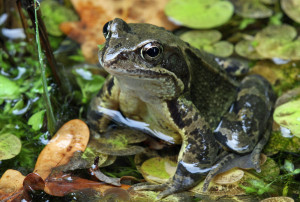Grass frog
 In its appearance close to the moor frog, the grass frog differs from it by larger size (up to 100 mm), dark marble pattern on the belly, a blunt face and a low internal heel protrusion. This species – quite multiple here – spends all summer on land, departing rather far from water bodies but settling in wet biotopes only. Distribution of grass frogs on land is predetermined by their dependence on humidity. In that regard, they are somewhere in between green frogs and toads.
In its appearance close to the moor frog, the grass frog differs from it by larger size (up to 100 mm), dark marble pattern on the belly, a blunt face and a low internal heel protrusion. This species – quite multiple here – spends all summer on land, departing rather far from water bodies but settling in wet biotopes only. Distribution of grass frogs on land is predetermined by their dependence on humidity. In that regard, they are somewhere in between green frogs and toads.
Nutrition of grass frogs is similar to that of moor frogs. These frogs are most active on July and August nights – usually the hottest nights of the season. Grass frogs cease all activity with the coming of regular cold nights, when the average daily air temperature drops under 6° Celsius. Among the local amphibians, grass frogs stand out with rather short hibernation. On average, it comprises 155 days – only common newts and fire-bellied toads winter less. Almost any water pool that does not freeze top to bottom can serve as winter quarters for the grass frog. However, it predominantly prefers non-freezing rapid streams with fewer rocks, and then peat ditches and bogs with fat ooze. The fewest hibernating species can be spotted in bigger rivers, given lack of backwaters. The vast spring floods in such rivers make it hard for the frogs to come ashore. Finally, in bigger rivers there are more predatory fish exterminating considerable numbers of frogs over the winter. Certain birds eat frog roe – such as gadwalls, widgeons, mallards, moorhens, black-tailed godwits, and black terns. Tadpoles were registered in the forage of rollers, magpies, fieldfares and redwings, whereas adults occur in nutrition of black-headed gulls, black storks, goshawks, buzzards, honey buzzards, spotted eagles, marsh harriers, eagle owls, boreal owls, ravens, butcherbirds, and red-backed shrikes.
/ * The photos at lake.peipsi.org are cross-posted from commons.wikimedia.org and are used for familiarization purposes only. No commercial use of the photos is allowed. For more information about to use the photos see the originals on commons.wikimedia.org. /


